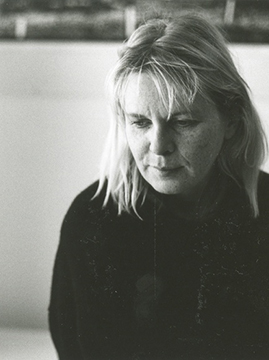Karen Casey (artist) facts for kids
Karen Casey (born January 7, 1956 – died October 15, 2021) was an amazing Australian artist. She was part of the Palawa people from Tasmania, Australia. In 2003, she was chosen as Melbourne's Artist in Residence. This meant she got to live and create art in the city for a special period.
Contents
Karen Casey's Early Life and Art Training
Karen Casey was born in Hobart, Tasmania. This is an island state in Australia.
She went to art school at the Tasmanian College of Advanced Education. There, she learned about silversmithing. This is the art of making things from silver. After art school, she moved to Melbourne. She worked there as a graphic designer. Graphic designers create visual designs for things like websites and advertisements.
Karen Casey's Art Career and Projects
Karen Casey started showing her art in the late 1980s. For over 30 years, she worked with many different types of art. These included painting, printmaking, and even video art. She also created large art installations and public art.
Exploring Ideas in Her Art
Karen Casey's art often explored big ideas. She looked at how different cultures and spiritual beliefs connect. She also thought about how these ideas relate to modern science. Casey was very interested in metaphysics. This is a part of philosophy that studies the basic nature of reality. She also explored consciousness (being aware) and interconnection (how everything is linked). These ideas deeply influenced her artwork.
One of her pieces, Got the Bastard, shared new insights. It showed what life was like for Aboriginal women. In 1987, she joined an exhibition called "Aboriginal Australians in Print and Poster". This show was put together by both Aboriginal and non-Aboriginal people.
Collaborative Artworks and Awards
Karen Casey worked with other artists on special projects.
- In 2000, she teamed up with Damian Smith. Their artwork, called Bruny, won the Art of Place Reconciliation Award. This award was part of the Fifth National Indigenous Heritage Art Awards. Their artwork was also shown in the Art of Place exhibition.
- In 2006, she worked with Darryl Cowie. They created a sculpture called the Reconciliation Touchstone. This sculpture included the imprints of 64 handshakes. It was a symbol of people coming together.
In 2012, Karen Casey received a very important award. It was the National New Media Art Award. This is the biggest award in Australia for new media art. New media art uses technology like computers and video.
Later Works and Unique Art Forms
In 2021, Karen Casey submitted two artworks to the RMIT Gallery's Future U project. She used special medical scans of her own body for these pieces.
- She used MRI and CT scans of her liver. From these scans, she made an animated film called Transplanted. An art critic called this film "remarkable".
- She also created a duratran print called Transmutation. This print included a CT scan of her own head. Duratran prints are special photos often used for backlit displays.
Where to Find Karen Casey's Art Collections
Karen Casey's artworks are held in many important art collections around the world.
- Art Gallery of New South Wales (Australia)
- National Gallery of Victoria (Australia)
- Gallery of Modern Art (QAGOMA) (Australia)
- British Museum (United Kingdom)
- Seattle Art Museum (United States)
Images for kids



